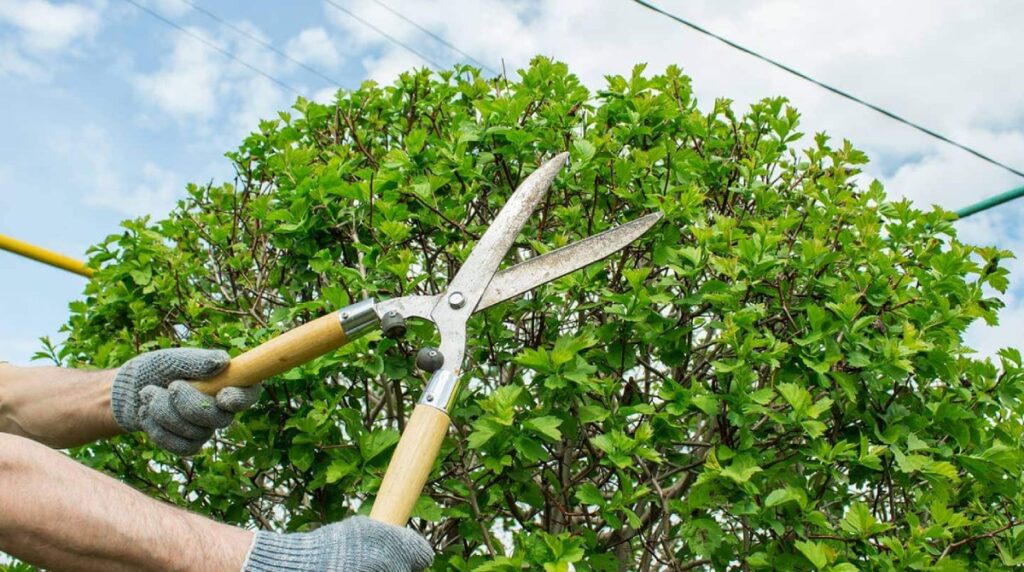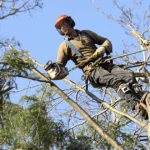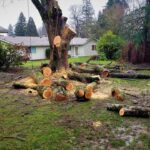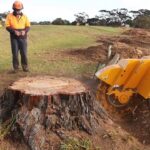Tree lopping is a vital aspect of maintaining a healthy and visually appealing landscape. By understanding the process and its benefits, you can make informed decisions about the care of your trees. In this comprehensive guide, we will delve into the science behind tree lopping, the necessary tools and steps involved, safety measures to follow, the impact on tree health, and its role in enhancing the aesthetics of your landscape.
Understanding Tree Lopping: An Overview
Tree lopping, also known as tree pruning or trimming, is the process of cutting specific parts of a tree, such as branches or limbs, to improve its overall structure, health, and appearance. It is essential to note that tree lopping should be carried out by professionals with experience and knowledge in arboriculture to ensure its effectiveness and prevent any harm to the tree.
Tree lopping is a practice that has been refined over centuries, blending art and science to achieve optimal results for tree care. The meticulous process involves not just cutting branches but understanding the tree’s unique characteristics, growth patterns, and environmental factors to make informed decisions about which parts to trim.
Defining Tree Lopping
Tree lopping involves carefully assessing the tree’s needs and selectively removing specific branches or limbs. This process promotes better tree growth, reduces the risk of falling branches, and enhances the tree’s structural integrity.
When done correctly, tree lopping can also stimulate new growth in the tree, leading to denser foliage and a more aesthetically pleasing shape. It is crucial to consider factors such as the tree species, its age, and the time of year when planning and executing a tree lopping operation.

The Science Behind Tree Lopping
Tree lopping is based on the scientific understanding of tree biology and growth patterns. By removing dead, diseased, or damaged branches, the tree is relieved of unnecessary weight and stress, allowing it to allocate resources more efficiently. Moreover, tree lopping can improve air circulation and sunlight penetration, fostering a healthier environment for the tree to thrive.
Professional arborists use specialized tools and techniques to ensure precise cuts that promote healing and minimize the risk of disease or pest infestation. Understanding the intricate balance between tree pruning and the tree’s natural response mechanisms is key to achieving long-term benefits for the tree’s health and vitality.
The Process of Tree Lopping
Before embarking on tree lopping, it is crucial to have the necessary tools and knowledge to perform the task safely and effectively. Tree lopping, also known as tree trimming or pruning, is a common practice in arboriculture to maintain tree health and aesthetics.
Tree lopping should be approached with caution and respect for the tree’s well-being. Improper lopping techniques can lead to tree stress, disease susceptibility, and structural instability. Learn more about disease susceptibility at https://www.genome.gov/genetics-glossary/Susceptibility
Necessary Tools for Tree Lopping
To execute tree lopping properly, arborists utilize a range of specialized tools, including pruning shears, loppers, pruning saws, and pole saws. These tools enable precise cuts while minimizing damage to the tree. It is essential to keep these tools sharp and well-maintained to ensure clean cuts that promote faster healing.
Additionally, safety equipment such as gloves, goggles, and helmets should be worn during tree lopping to protect against potential hazards like falling branches or debris.
Step-by-Step Guide to Tree Lopping
1. Assess the tree: Identify any dead, diseased, or damaged branches that need to be removed. Additionally, determine the desired shape or structure for the tree. Proper assessment is key to creating a lopping plan that benefits the tree’s health and appearance.
2. Plan the cuts: Carefully plan where to make each cut to avoid causing unnecessary stress or damage to the tree. Always cut just outside the branch collar, the swollen area where the branch meets the trunk or larger branch. Strategic cutting helps prevent disease entry points and promotes proper healing.
3. Make the cuts: Using the appropriate tools, make clean and precise cuts. Start with smaller branches and work your way up to larger ones. Avoid tearing or ripping the bark, as this can slow down the tree’s healing process and leave it vulnerable to pests and diseases.
4. Prune with care: Remove the branches in stages to avoid removing too much foliage at once, which may shock the tree. Proper pruning techniques help maintain the tree’s natural shape and encourage new growth.
5. Dispose of cut branches appropriately: Gather and remove the cut branches from the site, ensuring they do not pose a hazard or promote the spread of disease. Consider composting or recycling the branches to minimize waste and benefit the environment.
Safety Measures in Tree Lopping
Tree lopping involves working at heights and with sharp tools, making safety precautions paramount. Ensuring the well-being of both the arborist and those in the vicinity is crucial for a successful and incident-free tree lopping operation.
Before embarking on any tree lopping task, it is essential to have a comprehensive understanding of the safety measures and protocols involved. By adhering to industry best practices and regulations, arborists can mitigate risks and create a secure working environment.
Personal Protective Equipment (PPE) for Tree Lopping
Arborists should always wear the necessary PPE, including hard hats, safety glasses, gloves, and chainsaw protection gear, to protect themselves from potential hazards during tree lopping. Additionally, specialized footwear with good grip is essential to prevent slips and falls, especially when working on uneven terrain or in inclement weather conditions.
Properly maintained and fitted PPE not only safeguards the arborist from injuries but also enhances overall efficiency and precision during tree lopping tasks. Investing in high-quality protective equipment is an investment in both safety and professional performance. Click here to learn more about PPE.
Safety Protocols to Follow
1. Assess the site: Evaluate the area for potential hazards, such as nearby power lines, unstable ground, or wildlife nests that may interfere with the tree lopping process. Conducting a thorough site assessment before commencing work is essential for preemptively identifying and addressing any safety risks.
2. Use proper techniques: Employ safe climbing methods or utilize an elevated work platform to access high branches. Proper training in tree climbing and cutting techniques is imperative to ensure the arborist’s stability and control while working at heights.
3. Have a spotter: If working at heights, it is important to have someone on the ground to assist and ensure the safety of both the arborist and those nearby. Effective communication between the arborist and the spotter is key to coordinating movements and responding promptly to any unforeseen circumstances.
Implementing these safety protocols and measures not only prioritizes the well-being of the arborist but also contributes to the overall professionalism and reliability of tree lopping services. By upholding stringent safety standards, arborists demonstrate their commitment to excellence and client satisfaction in every tree lopping project they undertake.

The Impact of Tree Lopping on Tree Health
Tree lopping has both short-term and long-term effects on the overall health and well-being of trees.
Tree lopping, also known as tree trimming or pruning, is a common practice in arboriculture that involves cutting off branches and foliage from a tree. While it can be beneficial when done correctly, improper tree lopping techniques can have detrimental effects on tree health and longevity.
Short-Term Effects of Tree Lopping
Immediately after tree lopping, the tree may experience some stress as it adapts to the removal of branches. The exposed areas where branches were cut can be susceptible to pests, diseases, and decay. It is crucial to apply wound dressings or sealants to protect these vulnerable areas and prevent infections. Additionally, proper watering and fertilization are essential to help the tree recover and stimulate new growth.
Long-Term Effects of Tree Lopping
Over time, tree lopping can promote healthier and more robust tree development. By pruning away dead or diseased branches, the tree can allocate its resources to essential areas, resulting in improved structural integrity and vitality. However, excessive or repeated tree lopping can lead to stress and weaken the tree’s natural defense mechanisms, making it more susceptible to environmental stressors and pathogens.
Furthermore, tree lopping can impact the aesthetics of a tree and its surrounding landscape. Proper pruning techniques can enhance the tree’s natural form and beauty, while improper lopping can result in unbalanced growth and unsightly appearances. It is essential to consult with certified arborists or tree care professionals to determine the appropriate lopping practices for maintaining tree health and promoting sustainable growth.
Tree Lopping and Landscape Aesthetics
In addition to its impact on tree health, tree lopping also plays a vital role in enhancing the visual appeal of your landscape.
When it comes to landscape aesthetics, tree lopping is a valuable tool that goes beyond just maintaining tree health. It allows for the shaping and sculpting of trees to fit seamlessly within your landscape design, creating a harmonious and visually appealing outdoor space.
Enhancing Landscape Visual Appeal through Tree Lopping
Tree lopping not only helps in maintaining the health of trees but also enhances the overall visual appeal of your landscape. By removing overgrown or misplaced branches, trees can be transformed into aesthetic focal points that complement their surroundings, adding a touch of elegance and charm to your outdoor environment.
Moreover, the process of tree lopping can be customized to suit your specific landscape design needs, whether you prefer a more formal and structured look or a more natural and organic feel. This flexibility in tree lopping techniques allows you to achieve the desired aesthetic outcome for your outdoor space.
Tree Lopping for Landscape Balance and Harmony
Properly lopped trees play a crucial role in creating a sense of balance and harmony within a landscape. By ensuring that the size and shape of trees complement the other elements in the surroundings, tree lopping helps in establishing a cohesive and visually pleasing outdoor environment.
Furthermore, well-maintained trees through lopping not only contribute to the aesthetic appeal of your landscape but also promote the overall well-being of the ecosystem. Healthy and visually appealing trees can attract wildlife, provide shade, and improve air quality, enhancing the overall quality of your outdoor space.
By understanding the process and benefits of tree lopping, you can effectively maintain the health and visual appeal of your landscape. Remember to enlist the services of experienced professionals, prioritize safety measures, and follow proper techniques to ensure the best results for your trees and outdoor space.
Other resources: Find Reliable Tree Loppers Near Me for Quick and Safe Tree Management





